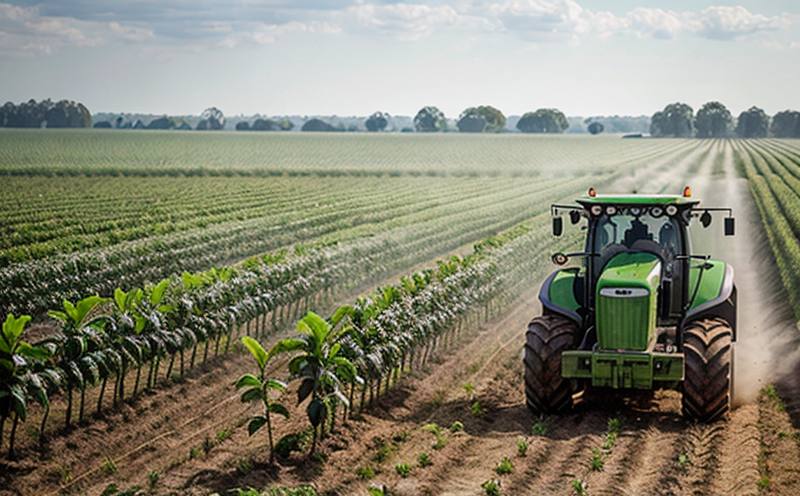EPA 2008 Metal Residue Testing in Agricultural Chemicals
The EPA Method 200.8 is a widely recognized and authoritative standard for determining the presence of metals, including heavy metals such as lead (Pb), cadmium (Cd), mercury (Hg), copper (Cu), and zinc (Zn), among others, in agricultural chemical formulations like pesticides, fertilizers, and soil conditioners.
The primary purpose of this test is to ensure that the levels of metal residues are within acceptable limits set by environmental regulations. This not only protects human health but also safeguards the environment from potential contamination. The method employs a multi-step process involving sample preparation, digestion, and instrumental analysis using inductively coupled plasma mass spectrometry (ICP-MS) or atomic absorption spectroscopy (AAS).
Sample preparation is critical for accurate results. This involves dissolving the agricultural chemical into an appropriate solvent system to ensure complete dissolution of all metal compounds while preserving the integrity of other components in the formulation.
The digestion process typically uses strong acids like nitric acid (HNO₃) and perchloric acid (HClO₄), which are capable of dissolving various organic and inorganic materials. Once digested, the solution is filtered to remove any particulates that might interfere with further analysis.
Instrumental analysis then follows using ICP-MS or AAS. Both techniques provide high sensitivity and precision necessary for detecting trace amounts of metals present in agricultural chemicals. ICP-MS offers a broader detection range, while AAS is more specific to individual elements like Cu or Zn.
The acceptable limits for metal residues depend on the specific formulation being tested and can be found in the EPA’s official guidelines under Method 200.8. For instance, certain heavy metals may have strict thresholds below which they must not exceed even trace amounts to avoid adverse effects on soil health or crop yield.
Compliance with these limits is crucial for maintaining product safety and efficacy while adhering to environmental protection standards. Failure to meet these requirements can result in recalls, fines, and damage to brand reputation. Thus, conducting thorough metal residue testing ensures that agricultural products remain safe and effective throughout their lifecycle from production to consumption.
Moreover, this testing supports sustainable agricultural practices by minimizing the risk of contamination while promoting healthier ecosystems. By ensuring that metals do not accumulate at harmful concentrations in soils or water bodies, we contribute significantly towards preserving natural resources for future generations.
Benefits
EPA Method 200.8 offers numerous advantages to stakeholders involved in agricultural chemical development and regulation:
- Regulatory Compliance: Ensures strict adherence to government regulations, thereby avoiding legal penalties.
- Patient Safety: Protects consumers from exposure to harmful levels of metals that could cause health issues.
- Eco-Friendly Production: Helps maintain ecological balance by reducing contamination risks associated with improper metal usage.
- Innovation Support: Encourages continuous improvement in formulation processes through precise testing.
Why Choose This Test
Selecting EPA Method 200.8 for metal residue analysis is advantageous due to its reliability and accuracy:
The method has been validated through extensive research and validation studies, ensuring consistent results across different laboratories.
It allows for the detection of trace amounts of metals, which are often challenging to quantify using other methods. This precision is essential for identifying potential contaminants early in the development process.
The standardized procedure minimizes variability between samples and operators, leading to more robust data that can be used effectively for decision-making purposes.
Additionally, this method supports research aimed at developing safer agricultural chemicals by providing detailed insights into metal content variations under various conditions.
Environmental and Sustainability Contributions
EPA Method 200.8 plays a pivotal role in promoting environmental sustainability:
By ensuring that agricultural chemicals contain acceptable levels of metals, this method helps prevent soil pollution and water contamination.
This precautionary approach supports sustainable agriculture by fostering healthy crop growth without compromising ecosystem integrity.
The reduced risk of metal accumulation in the environment translates into better air quality and more fertile soils, ultimately benefiting both agricultural productivity and biodiversity.
Furthermore, compliance with EPA Method 200.8 contributes to broader sustainability initiatives by aligning with international standards like ISO and ASTM, which emphasize responsible resource use and environmental stewardship.





